Author: Sirhc
FDIC lied about banks on purpose
Surge in China’s Demand for Gold Is Slowing as Economy Stumbles
The jitters affecting the world’s second-biggest economy are starting to feed through into China’s gold market.
Source: Bloomberg: Published Jun 19, 2023 • 2 minute read

(Bloomberg) — The jitters affecting the world’s second-biggest economy are starting to feed through into China’s gold market.
Article content
A surge in purchases by Chinese residents, driven by pent-up demand after three years of pandemic restrictions and optimism that the economy would quickly rebound, is starting to slow — yet another sign that the recovery is losing momentum.
China vies with India as the world’s biggest consumer of gold bars, coins and jewelry. Its central bank has also been a recent buyer, adding to its reserves for seven straight months after a three-year pause. Although most gold trades as a financial asset — notably as a haven for investors during risky times or as a hedge against inflation — China’s physical demand for the precious metal has helped underpin its ascent this year to over $2,000 an ounce.
The rapid expansion in retail sales of gold and silver jewelry looks to have topped out, rising 24% year-on-year in May to 26.6 billion yuan ($3.7 billion). That’s slower than the 44% and 37% growth recorded in the previous two months. The same period last year included the extended lockdown of Shanghai, when demand for goods and services cratered across the economy.
Lying Officials leave Americans unprepared
Gold appealing to younger family office investors amid market volatility
Source: CRAIN CURRENCY | Marcus Baram
Jun 15, 2023
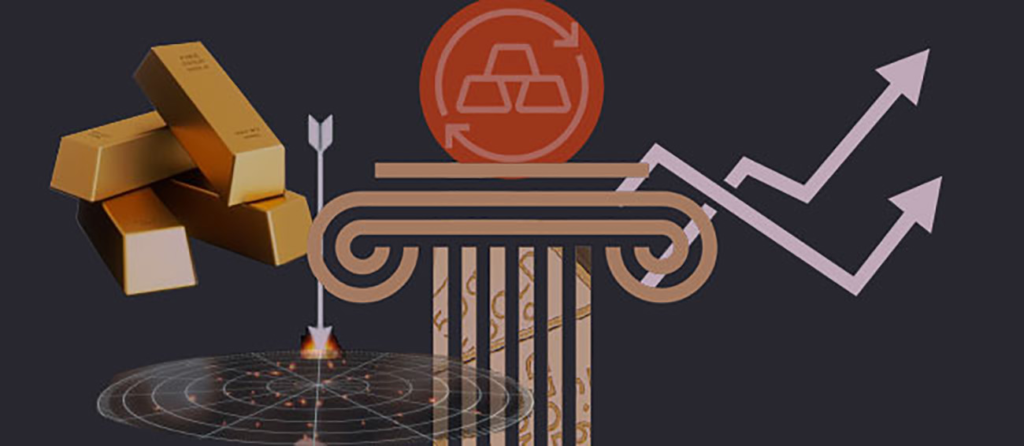
KRISTINA RUOTOLO
For centuries, gold has retained an allure as a safe-haven asset, especially during times of turbulence and market volatility.
Family offices and ultra-high-net-worth investors — using gold as part of their asset diversification strategy — have recently helped boost its price, which has increased 35% in the past five years. Traditionally favored by older investors, this time it’s attracting next-gen family office members, gold market analysts say.
“Since late 2022, investors appear to have gravitated toward the precious metal as a way to preserve their wealth and hedge against the risk of a recession later this year,” said Han Tan, chief market analyst at Exinity Group in Abu Dhabi.
Gold is often favored during times of crisis for several reasons. Despite its high price volatility, it is a relatively secure investment and extremely stable in value. Because it often goes against market and interest-rate changes, gold can serve as insurance against economic downturns. That’s partly due to its rarity and limited supply.
As a tangible asset, the precious metal — in the form of gold coins, gold bars or jewelry — protects investors against inflation, said Joseph Cavatoni, North American market strategist for the World Gold Council.
That protection appeals to family offices, which use gold to diversity their assets and as a “shock absorber in their portfolio” during these times of inflation and high interest rates, Cavatoni said. He’s seeing more interest from European family offices versus the U.S. market, though retail sales to consumers have slowed in India and China due to pandemic-related lockdowns.
“We’re seeing ultra-high-net-worth individuals come on the scene and make big purchases,” said Bill Voss, founder of Bullion Box, a subscription service that sends a curated box of precious metals every month. One favored strategy for investors, he said, involves building a portfolio that is one-third bullion, one-third semirare numismatic coins and one-third rare coins.
“Secondarily,” Voss said, “we’re being approached by family offices and other groups about acquisition opportunities in the sector.”
A major reason for gold’s recent price increase is that it’s being snapped up by more central banks around the world as part of their reserves portfolio, and it’s being used to manufacture electronics and many consumer products like cellphones, Cavatoni said.
Younger wealthy investors who may have been burned by the collapse of the crypto market also are increasingly turning to precious metals — including gold, silver and platinum.
“We’re getting so many requests from younger generations for precious metals,” Voss said. “It used to always be 50-something-and-older customers, but now it’s skewing much lower.”
Part of gold’s appeal is its tangible quality as a beautiful physical asset, Cavatoni said. For many people, it’s about “I can get a little bling and have it earn at the same time,” he said.
People who don’t necessarily trust the banks right now “want to hold something in their hands,” Voss said. “If more banks crash, they know they have something to go to and put their hands on.”
So far, the outlook for gold looks positive. Spot gold has advanced by more than 7% so far this year, said Exinity Group’s Tan, “on hopes that the Fed is approaching the end of the current rate-hike cycle.”
All that glitters for now just may be gold.
AUTHOR Marcus Baram
Marcus Baram is a contributing editor at Crain Currency, where he covers the intersection of finance and politics. Prior to joining Crain Currency, Baram was a staff writer at Fast Company and an editor at Huff Post. He has also written for outlets such as The New York Times, The Atlantic, and Vice. Baram is an expert on economic policy and has a deep understanding of the ways in which politics shapes the global financial system. In his role at Crain Currency, he brings a unique perspective to the complex and ever-evolving world of finance. With his keen analysis and clear writing, Baram helps readers make sense of the important issues impacting the economy today.
Gold can overcome near-term headwinds
Source: UBS CIO Daily Updates
by Chief Investment Office08 Jun 20233 min read
Thought of the day
The price of gold has remained under pressure following the stronger US employment report supporting expectations that the Federal Reserve will “skip” rather than ending hikes at its policy meeting next week. The potential for higher rates over coming months, after evidence of stubbornly high inflation, raises the opportunity cost of holding the precious metal, which generally doesn’t provide a yield. In addition, sentiment on gold was also undermined by International Monetary Fund data showing official gold reserves declined by 71 metric tons in April, which was the first net decrease in over a year.
As a result, gold has now fallen more than 5% from its recent peak in early May, when investors were more confident that the Fed had already finished its rate-hiking cycle. In our view, a further slide in gold to around USD 1,870 an ounce is possible (from USD 1,945 at present), as markets push back expectations for the start of rate cuts from the Fed.
But we still see potential gains for gold over the coming year, and we view the precious metal as a valuable hedge in portfolios.
Fed policy and the prospect of dollar weakness still supports gold. While the Fed is on a more hawkish trajectory than had been thought in early May, an imminent end to rate hikes still looks likely. In addition, the Fed is closer to starting a cutting cycle than its peers, including the European Central Bank (ECB). We also expect the Bank of Japan (BoJ) to back away from its ultra-easy monetary policy stance, relaxing its targets for government bond yields. This combination can be expected to weaken the US dollar, making gold less expensive for investors holding other currencies. Gold has historically performed well when the US dollar softens due to their strong negative correlation, and we see another round of dollar weakness over the next 6–12 months.
Central bank demand for gold should remain healthy, despite the recent decline. The decline in official holdings reported by the IMF does not reflect a reduction in enthusiasm for gold among central bankers, in our view. The Turkish central bank was reported as the major seller, but the World Gold Council believes these sales were due to local dynamics rather than a change in the central bank’s long-term strategy.
The longer-term trend suggests no reduction in appetite for gold among central bankers. Last year marked the 13th consecutive year of net gold purchases by global central banks and the highest level of annual demand on record dating back to 1950. At 1,078 metric tons in 2022, central banks’ buying of gold more than doubled from 450 metric tons in 2021. Based on the 1Q23 data from the World Gold Council, central banks are on track to buy around 700 metric tons of gold this year, much higher than the average since 2010 of below 500 metric tons.
Geopolitical and economic uncertainty could boost demand for gold among both investors and central banks. Gold has long benefited from safe-haven inflows during periods of geopolitical strife. The intensifying rivalry between the US and China, along with tensions arising from Russia’s invasion of Ukraine, make further flare-ups more likely. In addition, gold’s relative performance versus the S&P 500 improves significantly during US recessions, based on data since the 1980s. While recent US economic data have been resilient, stubbornly high inflation raises the risk that the Fed will overshoot in tightening rates—especially if regional banks continue to cut back lending to ensure liquidity following recent deposit outflows.
So, we continue to see upside in gold over the coming year. We keep our forecast of USD 2,100/oz by year-end and USD 2,250/oz by mid-2024 unchanged.
Very Rare 1870-S Gold Dollar NGC MS65
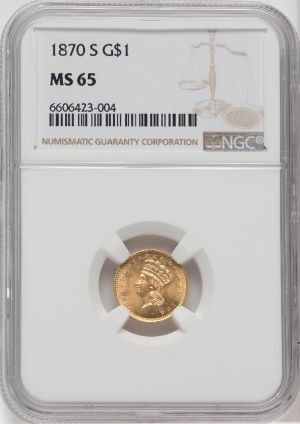
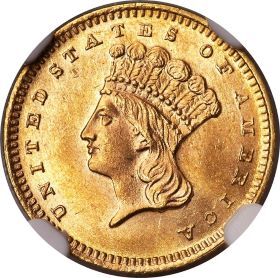
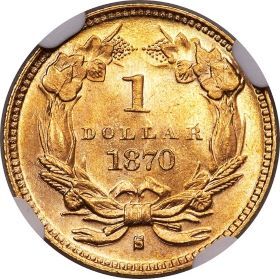
This date-mintmark combination is famous because of the unique three dollar gold piece. Although far from unique, specialists in this series recognize the 1870-S gold dollar as a challenging issue. Dave Bowers points out in A Guide Book of Gold Dollars that despite a reported mintage of 3,000 pieces, “it is likely that 2,000 lacked the S mintmark.” Indeed, the first sets of dies sent to the San Francisco Mint for 1870 production inadvertently lacked the mintmark. On May 14, the superintendent of the S-mint sent a telegram to Philadelphia explaining that 2,000 coins had been struck from those dies and asking whether or not they could be issued. It is not known for certain if those pieces were distributed. Assuming they were, that would leave a net mintage of only 1,000 1870-S gold dollars with the identifying mintmark. It may also explain why Augustus G. Heaton called this issue “excessively rare” in his 1893 treatise.
Tied with two others for the highest graded by NGC.
Listed at $38,000 intheNGC price guide.
Offered at $26,700 (ACH, Bank Wire, add 3.5% for Major CC & PayPal)
We do business the old fashioned way, we speak with you.
(800) 257.3253 8:30 AM – 5:00 PM CST M-F
Private, Portable, Divisible Wealth Storage
Dazzling 1881 Trade Dollar NGC PR67 Cameo
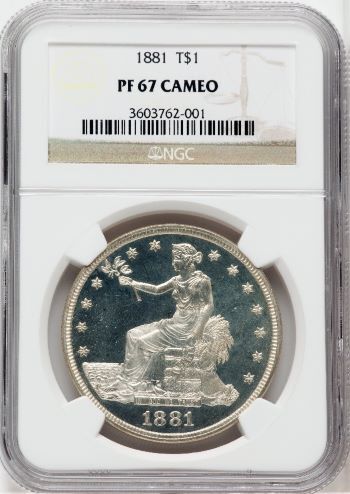
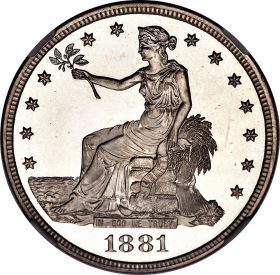
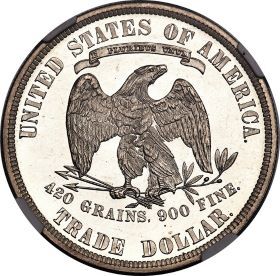
The Trade dollar was not produced in business-strike format after 1878, but the Philadelphia Mint coined a limited number of proof coins every year to satisfy collector demand. This led to a short-lived speculation in Trade dollars that crested early in 1880, leading to a series-record proof mintage of 1,987 pieces that year. By 1881, the demand had dropped off considerably, and only 960 proof Trade dollars were struck. In addition to the smaller mintage, the 1881 issue was plagued by poor workmanship, and most examples seen show areas of flatness on Liberty’s head and the upper stars, due to improper spacing of the dies. One of the reverse dies was lapped, resulting in a loss of detail in the eagle’s feathers. Few examples show the desirable Cameo effect. This particular survivor is color-free, with clear, deeply reflective mirrors and loads of eye-appeal.
The NGC population is 11 with 3 graded higher.
Offered at $19,620 (ACH, Bank Wire, add 3.5% for Major CC & PayPal)
We do business the old fashioned way, we speak with you.
(800) 257.3253
8:30 AM – 5:00 PM CST M-F
Private, Portable, Divisible Wealth Storage
Elusive 1895-O Morgan Dollar NGC MS61
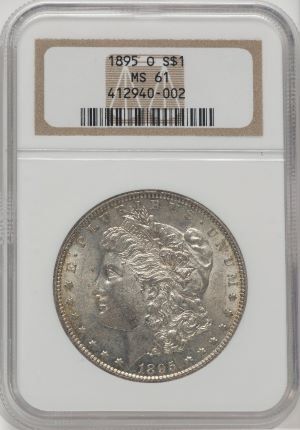
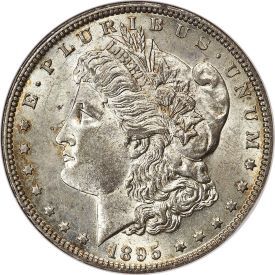
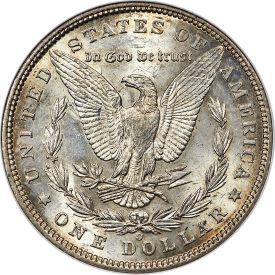
Silver dollar production declined drastically at all U.S. mints in the mid-1890s. Following the Panic of 1893 and the repeal of the Sherman Silver Purchase Act there was no commercial demand for the coins and no official mandate to produce them. Accordingly, the New Orleans Mint struck a small mintage of just 450,000 Morgan dollars that year. Unfortunately, the issue was not well-produced and many examples seen have weak strike characteristics and subdued mint luster. Most of the mintage circulated widely near the time of issue and the 1895-O was not well-represented in the Treasury releases of the 1960s. As a result, the 1895-O can be located in circulated grades without much difficulty today, but it is the third rarest Morgan dollar in Mint State grades behind the elusive 1892-S and the famous key 1893-S. The one offered here is lightly toned, lustrous and closer in appearance to our non-slab images than our slab-shot.
The NGC population is 60 with 54 graded higher.
Listed at $20,000 in the NGC price guide.
Offered at $16,985 (ACH, Bank Wire, add 3.5% for Major CC & PayPal)
We do business the old fashioned way, we speak with you.
(800) 257.3253 8:30 AM – 5:00 PM CST M-F
Private, Portable, Divisible Wealth Storage
1929 $20 Saint Gaudens – PCGS MS64
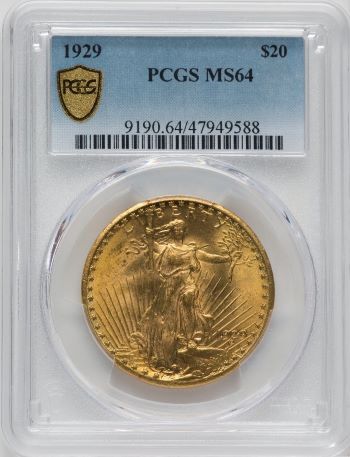
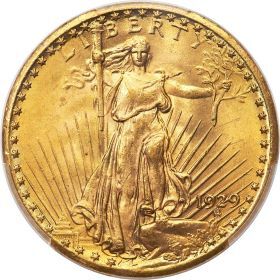
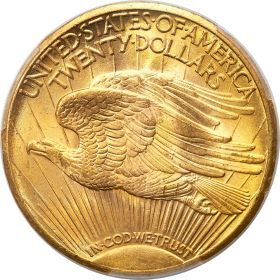
After numerous common date Philadelphia Mint double eagles were issued through 1928, mintages continued at substantial levels in 1929 and beyond. However, beginning in 1929 these pieces were not widely distributed, but rather, were stored in Treasury vaults awaiting their fate in the government melting pots of the mid and late-1930s. In Encyclopedia of U.S. Gold Coins, Jeff Garrett and Ron Guth wrote: “Beginning with the 1929 double eagle and continuing through the 1933 issue, any collector who undertakes obtaining these issues does so with extreme care and financial fortitude.”
The existing population of these pieces today survives from those few coins obtained by contemporary collectors, or from a small additional number of pieces that have been found in Europe. According to Roger Burdette, the maximum number of 1929 double eagles that could have survived is 1,176 pieces with the estimated survival of only 350 pieces.
The current PCGS population is 88 with 44 graded higher.
Listed at $86,400 in the CDN CPG and $90,000 in the PCGS price guide.
Offered at $81,000 (Bank Wire, ACH, Delivered)
We do business the old fashioned way, we speak with you.(800) 257.3253
8:30 AM – 5:00 PM CST M-F
Private, Portable, Divisible Wealth Storage